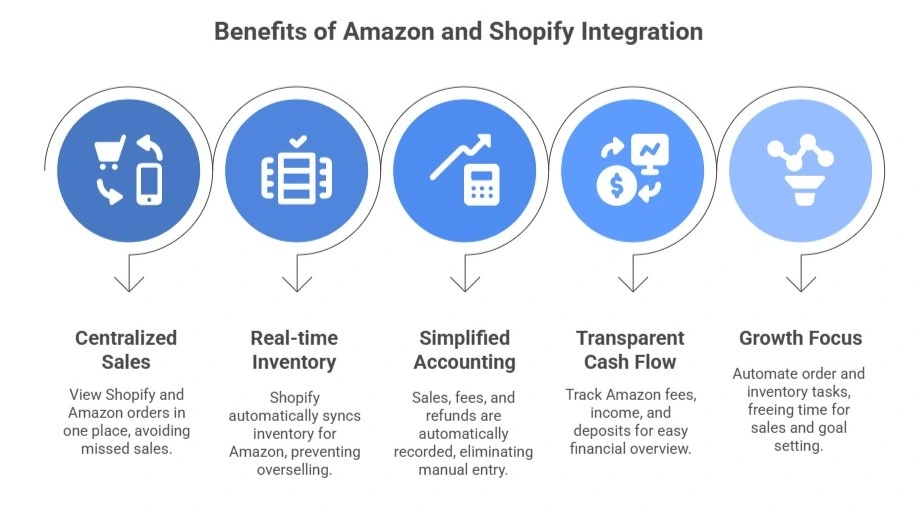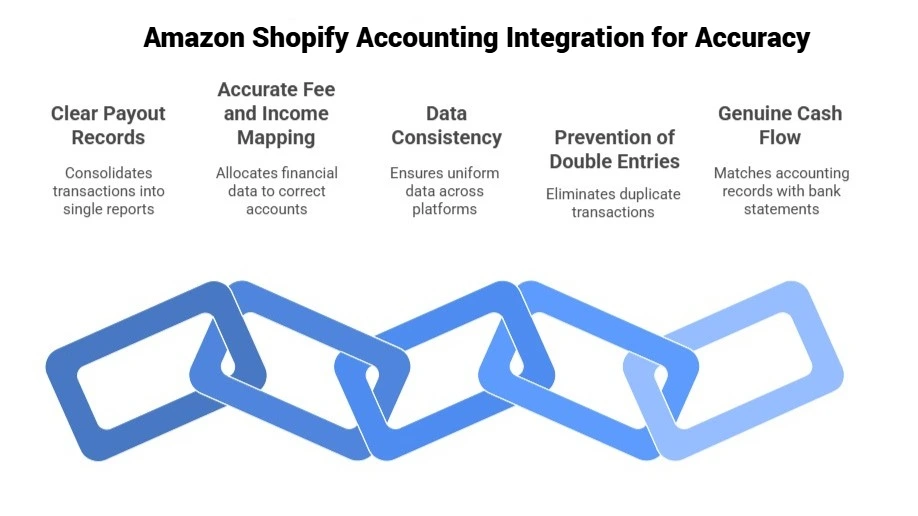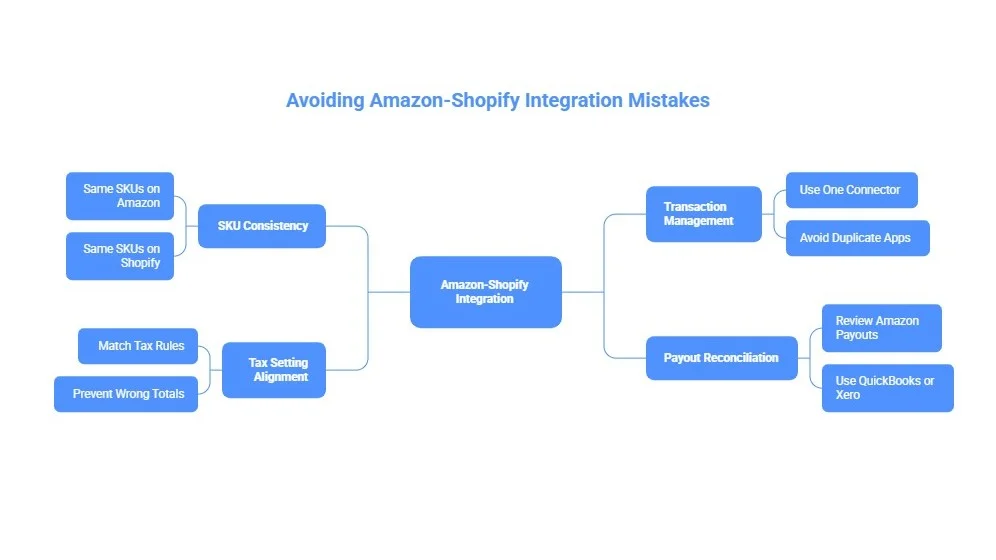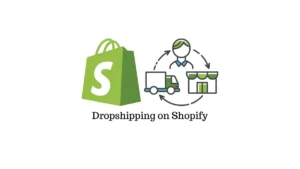Our goal is simple: to help you understand how to integrate Amazon with Shopify so that your sales, accounting, and inventory are always in sync. But this could surprise you: More than 61% of multi-channel suppliers lose money every year because of data that doesn’t work together and transactions that happen more than once between marketplaces. This means the tools that are designed to assist them grow their business often end up damaging their bottom line.
We at SAL Accounting will teach you the easiest way to connect Amazon and Shopify in this post. You can make sure your bookkeeping is done automatically and your accounting is always correct.
Quick Takeaways
- Amazon and Shopify integration keeps sales, inventory, and accounts aligned across both platforms.
- Tools such as A2X and QuickBooks ensure accurate accounting and clear financial records.
- Matching SKUs on Amazon and Shopify prevents overselling and data mismatches.
- A strong Shopify Amazon bookkeeping setup saves hours each week and improves profit accuracy.
- Regular checks of payouts, stock, and reports keep multi-channel accounting consistent and error-free.
What Is Amazon and Shopify Integration and Why It Matters
When you connect your Amazon and Shopify stores, sales, stock, and fees all update at the same time. When someone buys something on Amazon, it also shows up in Shopify. You don’t have to fix anything by yourself. Without this framework, things go wrong quickly. Let our e-commerce accountant manage your Shopify and Amazon sync for better accuracy.
Benefits of Connecting Amazon and Shopify for Multi-Channel E-Commerce
Shopify and Amazon work together to help your business grow and run effectively. This mix keeps things tidy, in order, and right. The best Shopify integrations and Apps keep everything hassle-free. This is why it is good for you:
- One Place for All Sales: You can see all of your Shopify and Amazon orders in one place. You won’t have to go to other sites or miss a sale.
- Get updates on stock right away: Are you trying to sell something on Amazon? Your inventory is automatically synced by Shopify. Don’t sell too much and keep calm.
- Easy Accounts: Your books get all the sales, fees, and refunds right away. You don’t have to write things down twice or fix things by hand.
- Clear Cash Flow: You can easily keep track of Amazon’s fees, your income, and your bank deposits. You can quickly see how much money you have. Cash flow statements for Shopify and e-commerce stores will be much easier.
- Time to Grow: Set up automatic order and inventory chores. You don’t have to conduct boring data work; you can focus on sales and making goals.

Step-by-Step Shopify Amazon Integration Guide
A proper setup keeps Amazon and Shopify connected, accurate, and easy to manage. Follow these steps to link both platforms the right way. Check out the guide on Shopify taxes in the US and Canada for more.
Step 1: Connect Shopify with Amazon
To add Amazon to your Shopify dashboard, click on “Sales Channels.” Sign in to your Amazon Seller account. After the two systems are connected, they can communicate information about orders and products.
Pro Tip: Use the same email address for all of your accounts, as a tip. Afterward, it’s easier to look for help and relationships.
Step 2: Put your items in the appropriate order
Make sure that the prices, names, and stock keeping unit (SKUs) of the items are the same on both sites. This helps Amazon and Shopify locate the proper things to sell. If the details are different, the systems will think they are different items, and the stock counts won’t match.
Pro Tip: Use short, clear SKUs like “TSHIRT-BLACK-M” as a tip. Don’t use spaces or symbols to avoid problems with synchronizing.
Step 3: Sync your inventory
Make your inventory sync automatically. Shopify updates its inventory instantly when something sells on Amazon. This step makes sure that people don’t sell too much and that the stock numbers are correct. You must know how to handle inventory accounting in Shopify.
Pro Tip: Check that both stores are in the same time zone and use the same currency. Stock or sales could take longer in different scenarios.
Step 4: Link your accounting software
Shopify can connect to QuickBooks, Xero, or A2X. These tools make sure that your sales, fees, and payouts are all proper by putting all of your Amazon data into one report.
Pro Tip: Grouping transactions by payout is easy using A2X. It keeps your books simple and ready for tax season.
Step 5: Test out your setup
Do a little test order to make sure the link works. Your accounting software should keep track of the sales, your inventory should change, and Shopify should show it. Use the top accounting software for Shopify to get better results.
Pro Tip: Write out a short list of things to do after the upgrades. You can spot little sync problems immediately if you check often.
| Step | Action | Purpose | Extra Note |
| 1. Connect Shopify with Amazon | Add Amazon in “Sales Channels” and sign in to Seller account. | Sync orders and products. | Use the same email for all accounts. |
| 2. Match Product Details | Align titles, prices, and SKUs on both stores. | Keep listings identical. | Use short, clear SKUs (TSHIRT-BLACK-M). |
| 3. Sync Inventory Automatically | Turn on real-time stock sync. | Prevent overselling. | Match time zone and currency. |
| 4. Link Accounting Software | Connect QuickBooks, Xero, or A2X. | Combine sales and fees. | Group entries by payout for clean books. |
| 5. Test the Setup | Place a test order and check data flow. | Verify accurate syncing. | Keep a short checklist after updates. |
Why Amazon Shopify Accounting Integration Matters for Accuracy and Profit
Your books will be correct, and your financial reports will be reliable if you have a good Amazon Shopify accounting integration. This is among the best accounting practices for Shopify stores to stay compliant. It sends every transaction from both platforms straight to your accounting system, so your numbers are always right. Here is what the integration does:
- Makes one clear record for each payout: Your accounting software gets one tidy report for each Amazon or Shopify payout instead of hundreds of tiny transactions.
- Correctly maps each fee and income: All of the sales, shipping charges, taxes, and Amazon fees go to the right chart of accounts.
- Keeps data consistent: The same statistics show up in your accounting software, Amazon reports, and Shopify dashboard.
- Stops double entries: The system checks for duplicates before they get to your books.
- Shows genuine cash flow: Every payment in your accounting software matches what goes into your bank account.
Pro Tip: Look at your integration reports once a month. Check to see if the account mappings and payout schedules still match. Small changes today will save you money on big cleanups later. Improve your Shopify accounting and bookkeeping with automated integration tools today.

Top Tools for Amazon–Shopify Integration
The right tool makes Amazon and Shopify integration simple and accurate. These apps handle sales data, inventory, and accounting automatically. Automating your Shopify store’s accounting and bookkeeping helps a lot. Here are the best options that keep both platforms connected and your books clean:
1. A2X Shopify Amazon
A2X gives the cleanest and most reliable connection between Amazon, Shopify, and your accounting tool. It groups transactions by payout, posts summaries automatically, and keeps your books audit-ready. Learn more about A2X for Shopify integrations.
Pro Tip: Choose A2X if accuracy is your top priority. It removes double entries and handles Amazon fees perfectly.
2. Webgility
Webgility fits larger sellers who manage multiple stores and heavy order volumes. It automates order sync, shipping data, and inventory across platforms. Webgility also includes advanced reporting for profit tracking.
3. Codisto
Codisto focuses on real-time listing and pricing sync. It lets you edit products once in Shopify and push those changes to Amazon instantly. This keeps both stores updated without manual work.
4. SyncSpider
SyncSpider helps sellers who need more custom control. It connects Shopify, Amazon, CRMs, and other tools through API-based automation. SyncSpider is perfect for businesses that need unique workflows.
5. QuickBooks Connector
QuickBooks Connector links Amazon and Shopify directly to your QuickBooks account. It transfers order, fee, and refund data automatically. Shopify integration with QuickBooks is great for small sellers who need simple automation without extra apps.
Pro Tip: Choose tools that offer daily syncs and payout summaries instead of per-order entries. It keeps your accounting cleaner and easier to review.
| Tool | Best For | Main Features | Accounting Compatibility |
| A2X | Accurate accounting sync | Groups payouts, records Amazon and Shopify data | QuickBooks, Xero |
| Webgility | Large multi-channel stores | Syncs orders, inventory, and shipping data | QuickBooks Desktop, QuickBooks Online |
| Codisto | Real-time product sync | Updates listings, prices, and stock instantly | Built-in with Shopify |
| SyncSpider | Custom integrations | Connects many marketplaces and CRMs | API-based, flexible setup |
| QuickBooks Connector | Small to mid-size sellers | Transfers orders and fees automatically | QuickBooks Online |
How to Avoid Common Amazon–Shopify Integration Mistakes
Even a small setup error can create accounting problems later. A few careful checks keep your Shopify Amazon integration stable and accurate.
- Different SKUs on each platform: Keep product SKUs the same on Amazon and Shopify. It helps both systems match sales and inventory correctly.
- Duplicate transactions in accounting tools: Use one connector only. Two active apps can record the same sale twice and distort your reports.
- Mismatched tax settings: Make sure tax rules match across Shopify, Amazon, and your accounting software. This step prevents wrong tax totals during filing.
- Unreconciled payouts: Review your Amazon payouts in QuickBooks or Xero often. It ensures your books show real cash flow. Learn more about Shopify integration with Xero.
Pro Tip: Run a short monthly review of your integration. Check SKUs, taxes, and payouts. Quick reviews stop small errors from becoming costly issues.
Case Study: How to Avoid Common Integration Errors1
Problem:
TechGears Electronics struggles with duplicate transactions in QuickBooks. They use multiple tools to connect Amazon and Shopify. This makes sales appear twice. Financial reports get messy and unreliable.
What We Do:
We help TechGears switch to A2X for Amazon and Shopify integration with QuickBooks. We set up automated transaction grouping in A2X. This sends only summary transactions to QuickBooks, stopping duplicates. We also check tax and inventory settings to ensure smooth syncing.
Results:
TechGears stops duplicate entries in QuickBooks. Financial reports become accurate. They save 6 hours a week fixing errors. Streamlined accounting and better order management increase profit margins by 10%.

How to Keep Your Amazon and Shopify Integration Running Smoothly
A strong Amazon and Shopify integration needs regular care to stay accurate and reliable. Small reviews and updates keep your data clean, your accounting correct, and your systems ready for growth. To keep your setup running smoothly:
- Check mappings often. Make sure every product, account, and tax code matches on both platforms. Even small mismatches can cause reporting errors.
- Update tools when needed. New app versions often fix sync issues and improve speed.
- Review Shopify payouts regularly. Match Amazon payouts with records in Shopify and your accounting software.
- Back up important data. Keep copies of your reports and transactions in case of connection errors.
Pro Tip: Create a simple monthly checklist for your Shopify Amazon sync. Review product SKUs, confirm a few sample transactions, and ensure the latest updates are installed correctly. These quick checks keep your integration healthy and your books consistent.
- Read More: “Shopify Tax Exemption Explained: What It Is and How to Set It Up for Your Store in 2025”
Case Study: Keeping the Amazon-Shopify connection running smoothly2
Problem:
EcoWear Apparel’s Shopify store is growing fast. But their Amazon integration causes trouble. Amazon sales don’t update Shopify’s stock. This leads to overselling and late deliveries. Customers get frustrated. Profits drop because of wrong inventory counts.
What We Do:
We use A2X to connect Amazon and Shopify. It syncs orders and inventory automatically. Real-time updates mean every Amazon sale adjusts Shopify stock instantly. A2X’s payout feature sends clear sales reports to QuickBooks. This makes accounting simple.
Results:
Inventory stays accurate. No more overselling. Customers are happier. EcoWear saves hours each week by avoiding accounting mistakes. Better sales and customer service boost revenue by 15%. Make e-commerce bookkeeping easier and error-free with seamless integration solutions.
Final Thoughts
Amazon and Shopify integration make e-commerce super easy. It saves you time and keeps sales, inventory, and accounts spot-on. This guide shows you how to skip mistakes and sync data smoothly. Use good tools and check stuff often to keep your store smooth and profitable.
For help with Amazon-Shopify setup or e-commerce accounts, contact us at SAL Accounting. We simplify things and help you make more money.
Amazon & Shopify Integration FAQs
Get an Amazon Professional Seller account. Set up your Shopify store for the same marketplace. Grab an app like CS Amazon Integration or Marketplace Connect. Connect accounts, sync products, and test a few items.
A2X is the top pick. It bundles payouts, sorts fees, and works with QuickBooks or Xero. Synder and Finaloop also do a solid job for multi-channel and real-time tracking.
Yes. Apps like CS Amazon Integration, SnapSync, or Trunk keep stock updated in real time. They manage levels across both platforms and handle FBA/FBM orders to avoid overselling.
Stick to one app like A2X or Synder to bundle payouts. Drop Shopify’s built-in integration. Match transactions to bank deposits and skip duplicates before importing.
Use A2X to sort Amazon fees like referrals and FBA. Add them as summary entries to the right accounts. Check payouts against bank deposits for accuracy.
No. Apps like CS Amazon or LitCommerce cover basic syncing. But A2X rocks for accurate accounting, bundling transactions, and avoiding errors in multi-channel setups.
Totally. Xero’s Shopify app syncs sales daily. A2X handles Amazon fees and payouts directly. This setup automates everything for both platforms in Xero.






